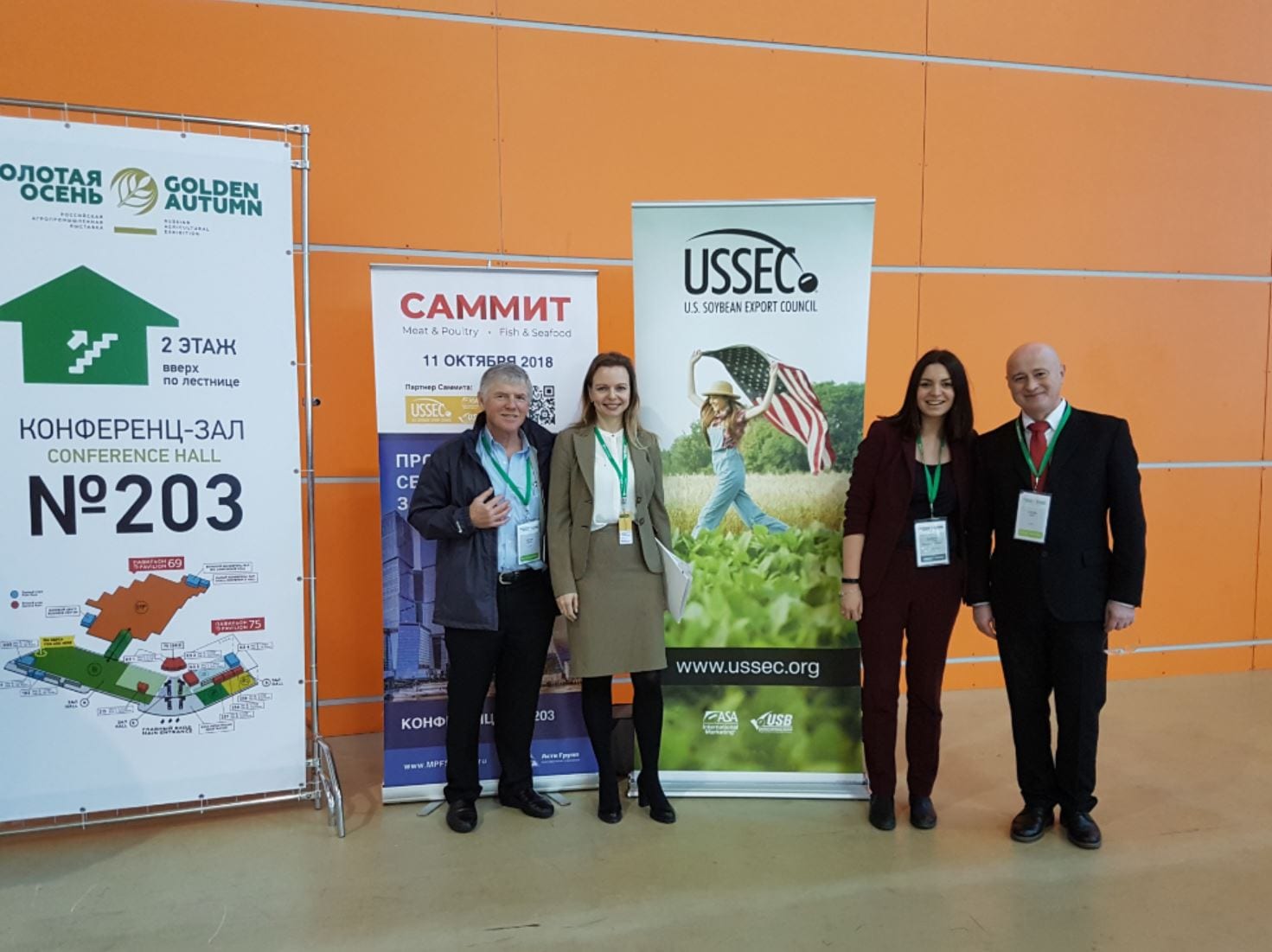Russian Federation's Feed Industry Hears U.S. Soy Message at ASTI Protein Summit 2018
- Category:
- Animal Utilization
- General News

In an effort to maintain relationships with customers and increase awareness of U.S. Soy, a USSEC delegation attended the ASTI Protein Summit 2018, organized in Moscow, Russia, in October. USSEC’s participation allowed interaction with representatives of key companies and organizations and offered the opportunity to increase awareness on U.S. Soy’s quality and availability from this year’s harvest. The summit took place at the VDNH Exhibition Center and was held within the framework of the business program of the Golden Autumn 2018 Agricultural Exhibition.
The rapid growth of Russia’s agriculture industry over the past few years is the result of international trade disruption policies and significant state support for the agri-business sector. Over $18 billion has been provided to agricultural businesses in the past 6 years. Currently, the feed and livestock industries from the European Russia area are benefiting from affordable prices for locally grown grains, which bring an advantage in terms of feed costs. However, the shortage of the local soybean crop this year highly influenced domestic market prices in Russia. Combined with limited possibilities to import soy, this caused significant increases in prices for feed. This reconfirms that the Russian crushing and feed industries need access to soy currently available at excellent prices from the international market. Meanwhile, a temporary solution is the use of alternative protein ingredients, which is being seriously considered, but education is needed for the proper and efficient use of these in animal diets. There are also risks involved from the substitution of conventional protein sources.

This year’s Summit’s key topic was “Protein: Yesterday, Present, Future.” The Summit tried to frame the situation of animal and vegetable protein resources globally in the chain “from feed to food.”
Two USSEC speakers went deep into the topic of protein in terms of animal feeding. In order to answer industry questions, USSEC consultant Dr. Iani Chihaia presented a review of current and novel alternatives, compared to the soybean and its derivative products: “It's Time to do More with Less: Squeezing Out More from Conventional, Alternative and Novel Protein Ingredients for Sustainable and Profitable Animal Nutrition” A Commercial Nutrition Practitioner's Point of View. The key message delivered to the audience was that soy remains the gold standard of the vegetal protein ingredients used in animal feeding and U.S. Soy has distinctive amino-acids profile and higher energy for poultry and swine.
Dr. Jan van Eys’s presentation, “Quality Evaluation and Energy Utilization; Not All Ingredients are Created Equal” emphasized the differences in energy value among soybean meals of different origins and ways to properly use these differences to maximum advantage for customers of U.S. Soy.

Dr. Maria Domoroshchenkova, local USSEC consultant, commented on the success of USSEC’s participation at the protein summit. “The conference was well attended with about 75 attendees, primarily key people in the Russian feed industry, feed utilizers, representatives of science, representatives of the legislative branch, analysts, investors, entrepreneurs, and top managers working in the agro-industry and journalists,” she said. “This offered a good opportunity to network with participants and position U.S. Soy products within the entire range of livestock feed products. Following the Summit, we had several meeting around the Golden Autumn Tradeshow, with personnel and companies involved in the use, development and marketing of specialty soy products. These contacts are promising and may lead to increased sales of U.S. Soy products if import restrictions will change.
“However, imports remain limited through phytosanitary issues and delays in registration in Russia of U.S. GM soy events. Additional marketing efforts by USSEC in this region should be considered and may have major pay off once the above-mentioned import restrictions will change,“ Dr. Domoroshchenkova added.

Several start-ups were established in Russia over the past two years, dealing with processing technologies to manufacture high protein meals from sunflower, canola, and lupine. Many of them succeeded to make commercially available protein meals, such as double dehulled sunflower meal, lupine meal, and bypass protein. However, it seems like a lot of effort is still needed to develop quality alternative protein meal products to suit the modern broiler nutritional requirements and that of high production swine and large ruminants. Even so, soybean meal seems to remain the gold standard and the use of alternative protein meals is fitting seasonally and only for some particular applications.
Another area of interest in Russia is the development of fishmeal replacements, such as single cell proteins and insect meals. Just a few weeks ago, a large Russian – Danish plant started up the production of single cell proteins from methane gas, while an insect farming project established during the past two years is a large experimental farm in the proximity of the Moscow area. In spite of high protein content and a good nutritional profile, insect meal production is facing several serious obstacles to make it available and economically feasible for use soon by the feed and aqua industries: there are no legal farming protocols for insects, in addition to a lack of knowledge regarding anti-nutritional factors in insect and extremely high production costs.
As a solution to the current limitation, consultants delivered as main message to the audience that soy should remain the gold standard of the vegetal protein ingredients used in animal feeding and, moreover, that U.S. Soy has distinctive amino-acids profile and higher energy for poultry and swine.